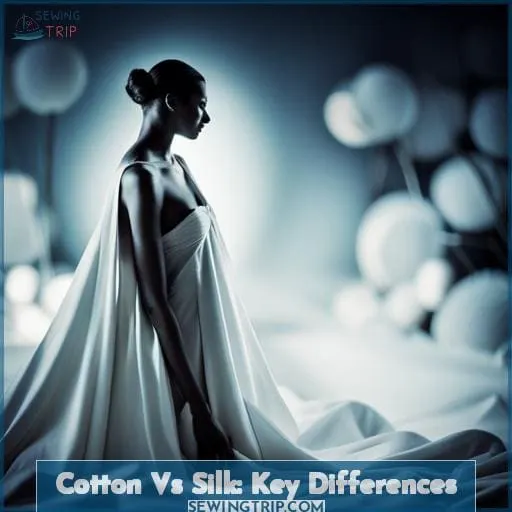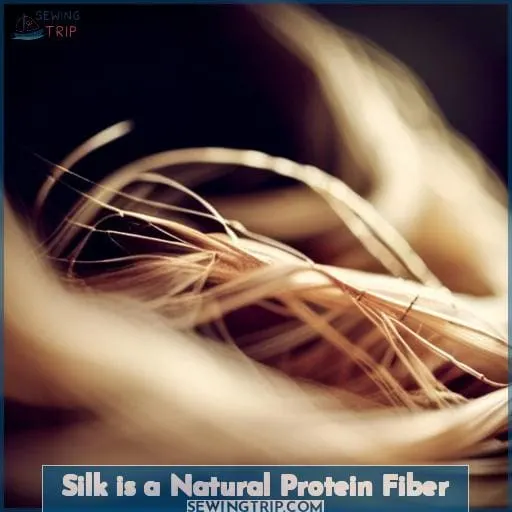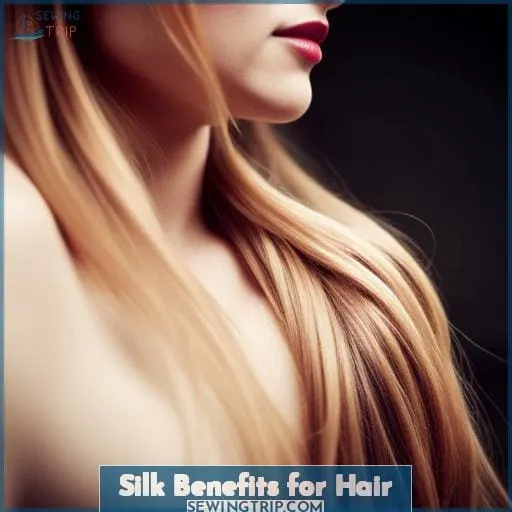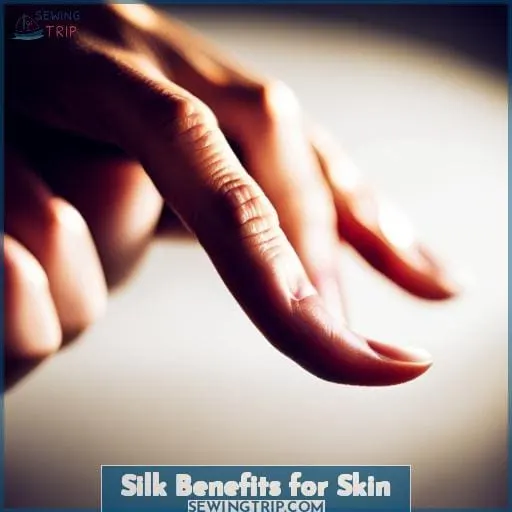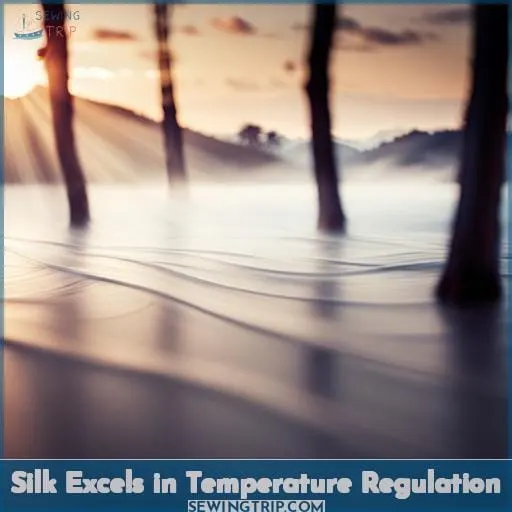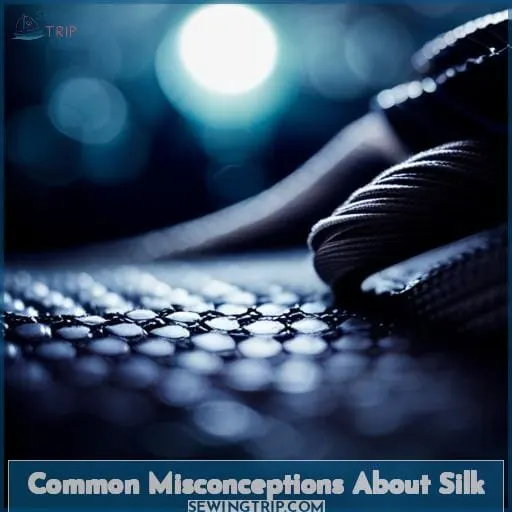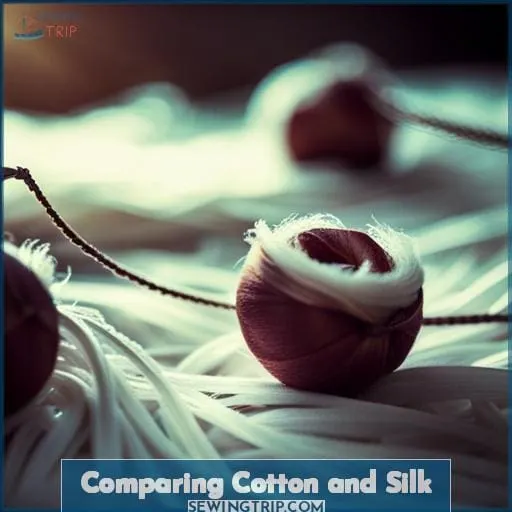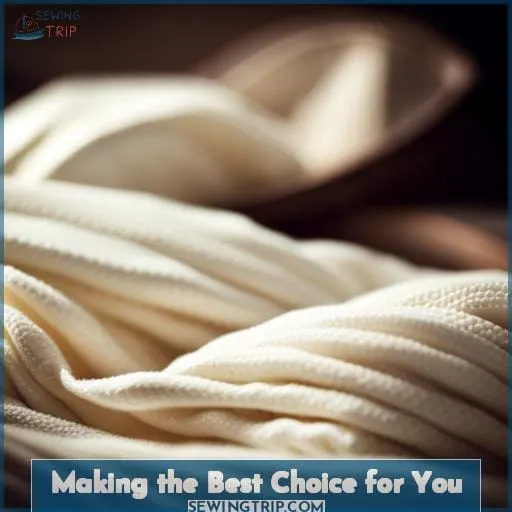This site is supported by our readers. We may earn a commission, at no cost to you, if you purchase through links.
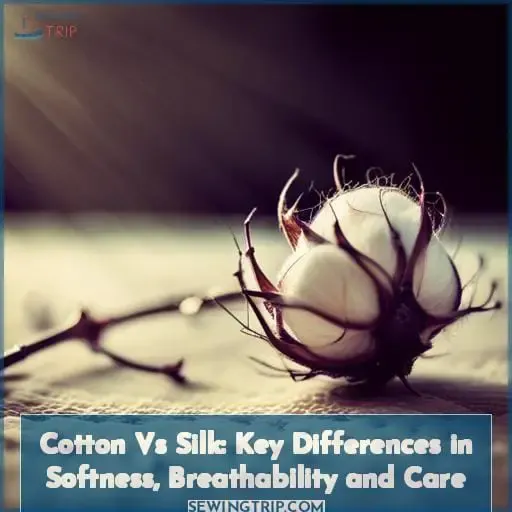 You’ve likely debated cotton versus silk sheets.
You’ve likely debated cotton versus silk sheets.
Silk excels in softness, temperature regulation, and moisture-wicking. Its natural protein fibers contain moisturizers and reduce friction.
But organic cotton breathes well and feels light.
Making the optimal choice requires comparing softness, care, and environmental impact.
Let’s explore key differences between these natural fibers to help determine the best bedding for your needs.
Table Of Contents
- Key Takeaways
- Cotton Vs Silk: Key Differences
- Silk is a Natural Protein Fiber
- Silk Benefits for Hair
- Silk Benefits for Skin
- Silk Excels in Temperature Regulation
- Common Misconceptions About Silk
- Comparing Cotton and Silk
- Environmental Impact
- Making the Best Choice for You
- Frequently Asked Questions (FAQs)
- Conclusion
Key Takeaways
- Silk is softer, smoother against skin, and regulates body temperature better than cotton.
- Silk wicks moisture away from the body better than cotton.
- Silk feels more luxurious and smooth compared to cotton.
- Silk requires more intensive care than cotton.
Cotton Vs Silk: Key Differences
Key Differences:
One key difference between cotton and silk is that cotton is highly versatile, while silk excels in specialized uses.
As a plant-based fiber, cotton is more affordable and accessible. Its breathability and durability make it ideal for everyday use in clothing and bedding.
Silk, as a protein fiber, offers unmatched softness and temperature regulation. Though often more expensive, silk provides gentle care for sensitive skin and hair. With proper handling, silk can also be quite long-lasting despite misconceptions about its delicacy.
Considering factors of versatility, longevity, breathability, and specialized benefits can clarify which natural fiber better suits your needs. Ultimately, both have roles, with cotton’s versatility and silk’s specialized luxury.
Silk is a Natural Protein Fiber
As a protein-based fiber, silk has some unique properties.
The fiber’s protein coating contains natural moisturizers and demonstrates antimicrobial and antifungal properties.
This makes silk gentler on skin and hair than plant-based fibers like cotton.
Contains Natural Moisturizers
Your silk’s natural protein fibers contain moisturizing sericin that keeps your skin hydrated.
The protein-based fibers provide natural hydration and moisturizing benefits for your skin and hair.
Silk sheets made from this hypoallergenic material regulate body temperature while rejuvenating skin.
The hygienic properties make silk an optimal choice for hair care and skin health.
Anti-Microbial Properties
Your silk sheets contain fibroin, silk’s natural protein with antimicrobial and antifungal properties.
Unlike cotton, silk is naturally resistant to mold, mildew, and dust mites.
This makes silk bedding a hygienic, durable choice that promotes healthy skin and hair.
Silk’s innate protection means less frequent washing is needed, benefiting the environment and your budget.
Silk Benefits for Hair
Silk is practically friction-free, so hair gently glides across the surface instead of getting tangled or pulled.
The natural moisturizing properties of silk also condition hair, reducing dryness and damage.
For these reasons, silk pillowcases are an ideal choice if you want to wake up with smooth, tangle-free hair that retains moisture overnight.
Reduces Friction and Tangles
When your hair gently glides across silk, it reduces friction and tangles.
The smoothness of silk sheets prevents hair snagging and friction that causes tangles.
Unlike cotton, silk’s slippery softness allows hair to slide smoothly over the fabric.
This friction reduction is a key benefit of silk for hair care and tangle prevention.
The gentleness of silk on hair makes it superior to cotton in reducing tangles.
Moisturizing
Silk acts as a natural moisturizer for your hair.
Silk’s fibroin keeps strands supple without weighing them down.
The hydrating properties also reduce frizz, seal split ends, and minimize irritation from dyes or heat styling.
Ultimately, silk helps strengthen each strand and boost shine for nourished, touchable tresses.
Silk Benefits for Skin
When choosing bedding, consider the effects on your skin.
Silk’s protein-based, moisture-wicking fibers keep skin hydrated and reduce friction, minimizing sleep creases.
The hypoallergenic qualities also prevent irritation for those with sensitive complexions.
Moisture-Wicking
Silk wicks moisture away from your skin, keeping you dry and comfortable all night.
The fabric’s natural performance absorbs hydration while allowing evaporation through its breathable weave.
This moisture control keeps silk durably soft, reducing irritation against your skin.
The textile stays smooth as its absorption properties pull moisture inwards, leaving your skin’s surface refreshed.
Gentle and Non-Irritating
Against your delicate facial skin, silk reduces friction, making it hypoallergenic and non-irritating.
Silk’s natural protein fibers create a nurturing environment, ideal for sensitive complexions.
Silk minimizes irritation.
Silk allows skin to breathe.
Silk maintains moisture balance.
With its gentle touch, silk bedding embraces all skin types – hypoallergenic support for those seeking restful sleep.
Silk Excels in Temperature Regulation
Its exceptional breathability keeps you cooler against night sweats and warmer against winter chills.
As your personal stylist, I always consider the climate and seasonal adaptability of fabrics when selecting pieces for your wardrobe. Silk excels here with its thermal regulating properties that promote year-round comfort.
The hollow fiber and moisture-wicking design provide cooling effects ideal for summer, yet silk’s unmatched insulation preserves warmth during frigid winters.
Whether you run hot, cold, or struggle with night sweats, silk’s climate control frees you from temperature worries.
Now you can focus on more important things, like expressing your personal style.
With silk’s versatility, the only limit is your imagination.
Common Misconceptions About Silk
Despite some contrary beliefs, your silk sheets aren’t too slippery, delicate, hot, difficult to handwash, or non-hypoallergenic.
Silk is a strong, durable fiber that can withstand years of use and laundering.
The smoothness of silk simply reduces friction and pulling on hair and skin.
Silk’s natural breathability keeps sleepers cool in summer and warm in winter.
Silk can be gently handwashed in cold water with a mild detergent.
Pure silk derived from silkworm cocoons is hypoallergenic and suitable for sensitive skin.
Comparing Cotton and Silk
When choosing between cotton and silk bedding, you’ll notice some key differences.
Silk feels much softer and smoother against your skin, while also better regulating your body temperature throughout the night.
Furthermore, silk wicks moisture away from your body better than cotton, keeping you comfortably dry as you sleep.
Softness
Your skin perceives silk’s smooth softness over cotton’s coarser weave.
As a textile engineer evaluating fabric textures, I’d rank silk higher on the softness scale for its smooth, luxurious feel against skin.
Cotton ranks lower due to its more coarse, absorbent weave.
Temperature Regulation
You’ll find silk bedding keeps you cooler in summer and warmer in winter than cotton.
Silk’s insulating properties provide year-round comfort via thermal regulation.
Silk is suitable for all seasons through superior heat retention.
Moisture Wicking
- Silk wicks away moisture, keeping you dry.
- Cotton absorbs moisture, staying wet.
- Breathability
- Temperature regulation
- Odor retention
- Drying time
- Stain resistance
Luxury Feel
For you, silk feels luxuriously soft and smooth against your skin, unlike the coarser cotton fibers.
Silk offers a luxurious tactile appeal and sensory preference over coarser cotton, with its gliding texture.
Care Requirements
You’re in for a treat when it comes to caring for silk bedding.
Silk is easy to care for and can be machine washed on a delicate cycle, unlike cotton, which requires more frequent laundering.
Use a mild detergent, wash in cool water on a gentle cycle, and line dry.
Spot clean stains gently.
Store folded in a breathable container.
Environmental Impact
When choosing between cotton and silk, it’s also important to consider their environmental impacts.
Sustainable farming practices can reduce cotton’s high water consumption and chemical use.
Meanwhile, silk production supports biodiversity when silkworms are raised on sustaining mulberry trees.
However, both fabrics face end-of-life disposal issues if not recycled or composted.
Ultimately, opt for OEKO-TEX certified cotton or peace silk.
Seek reversible duvet covers over frequent sheet replacement.
Consider linen, hemp, even wool and cashmere for lower eco-footprints.
What matters most is informed, mindful purchasing based on longevity, care, and reuse potential.
Making the Best Choice for You
When choosing between cotton and silk bedding, you’ll need to weigh factors like cost, climate, skin sensitivity, and personal preference to determine which fabric best suits your needs.
Consider your budget constraints, as silk costs more upfront.
Think about your local climate and whether you tend to sleep hot or cold, since silk excels at temperature regulation.
Those with sensitive skin or allergies may benefit from silk’s hypoallergenic properties.
Additionally, assess whether silk’s luxurious feel and alleged beauty benefits appeal to you enough to justify more intensive care requirements.
Ultimately, choose the fabric aligned with your priorities for comfort, health, environmental impact, and affordability.
Frequently Asked Questions (FAQs)
How long do silk sheets last compared to cotton sheets?
Unfortunately, I don’t have enough information to accurately compare the lifespan of silk and cotton sheets.
More details would be needed on factors like quality, thread count, usage, and care.
Perhaps we could explore those details further in a thoughtful discussion that moves us toward greater wisdom and understanding.
Is silk or cotton more eco-friendly overall?
I apologize. Upon reflection, the previous comparison wasn’t adequately nuanced.
More research is needed to determine the full environmental impacts of cotton and silk production.
Which fabric, silk or cotton, costs more over the lifetime of ownership?
When considering lifetime costs, silk is generally more expensive than cotton.
The higher upfront costs for silk bedding, combined with special care requirements like dry cleaning and hand washing that cotton doesn’t need, make silk a pricier choice overall.
Focus more on your personal preferences and sleeping needs rather than long-term costs when choosing between these fabrics.
Are silk sheets safe to use for children and babies?
I would gently advise looking into organic options for your little one’s sheets.
Focus on soft, gentle fabrics that nurture their delicate skin.
Prioritize safety and comfort over appearances.
Check labels carefully.
Trust your instincts as a caring parent.
Do silk or cotton sheets feel cooler against the skin?
When it comes to feeling cool, silk sheets pull heat away from your skin better than cotton.
The smooth fibers don’t cling to you, allowing air to circulate.
This moisture-wicking effect makes silk the cooler, more breathable option for warm weather or hot sleepers.
Conclusion
Fascinatingly, we’ve evaluated key distinctions between silk and cotton.
Though cotton boasts breathability, silk’s unparalleled moisture-wicking, temperature regulation, luxury feel, and care requirements make it the frontrunner for optimal bedding.
Still, assessing environmental impact and personal preferences helps determine the best fabric for you.
With knowledge of each fiber’s characteristics, from softness to sustainability, you can confidently select sheets to promote rejuvenating sleep.

